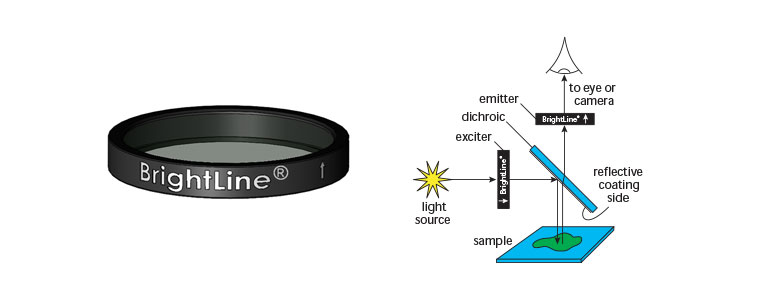

Optical Filters FAQs
Here we have provided comprehensive lists of commonly asked questions regarding our Semrock optical filters and related applications. This information is designed to support your inquiries, but if you don’t find the answers you are looking for we encourage you to contact us for further assistance.
Please use the sort buttons in the left navigation to navigate between questions and answers that are specific to Optical Imaging Systems, Fluidics, Cameras, Microfluidics, our Webstore, and Engineering Partnership.
What is filter orientation?
Orientation of Semrock Filters
Because of the durability of Semrock filters, you can easily populate filter cubes, filter sliders, and filter wheels yourself without fear of damaging the filters. To maximize intended transmission and blocking and to minimize autofluorescence, filters must always be oriented so that light is incident on a specific surface of the filter. This note describes the correct orientation for the different filter types.
Orienting Housed Excitation and Emission Filters
Semrock exciter and emitter filters mounted in housings feature an alignment arrow on the housing; see the illustrations below. Orient such a filter so that the arrow points in the direction of light propagation. For microscopes, the exciter filter arrow should point away from the light source and toward the dichroic beamsplitter, and the emitter filter arrow should point away from the dichroic beamsplitter and toward the eye, detector, or camera.
Dichroic beamsplitters are rarely mounted in housings. See below for guidance.

Orienting Dichroic Beamsplitters and Other Unhoused Optical Filters
Dichroic beamsplitters and other unhoused optical filters feature orientation marks that identify the coated surface upon which light must be incident. An orientation mark is placed either on the front surface of the filter, or on the edge of the filter as a caret (^) mark. The different types of orientation marks are shown in the following drawings along with the corresponding orientation guidance.

- Semrock logo: The logo is on the surface facing the incident light.
- Line: A short line is on the surface facing the incident light. The line may be easier to see if viewed at an oblique angle.
- Dot: A small dot is on the surface facing the incident light. The dot may be easier to see if viewed at an oblique angle.
- Caret: A caret on the edge of the filter points in the direction of light travel. When the viewer faces the surface that receives the incident light, the caret points away from the viewer.
Caution: A number of dichroic beamsplitters have coatings on both surfaces. Always use the above instructions to identify the coated surface that should face the incident light! If you encounter any ambiguity or difficulty, please contact Semrock for assistance in identifying the surface orientation.
Further Resources
Complete how-to instructions for microscope cube assembly are available in PDF format and video.
